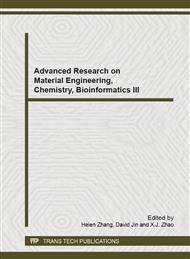p.270
p.274
p.278
p.282
p.286
p.290
p.294
p.298
p.302
Synthesis, Photochromic Properties of 1-(2-methyl-5-chlorine-3-thienyl)-2-(2-cyanophenyl) perfluorocyclopentene
Abstract:
An unsymmetrical diarylethene derivative bearing both phenyl and thiophene moieties, in which a cyano group was substituted at the ortho-position of the phenyl ring and a chlorine elements was substituted at the five-position of the thiophene ring, was synthesized. At the same time, its photochromic properties and fluorescence switch were investigated in detail. The results showed that this compound exhibited reversible photochromism, undergoing reversible cyclization and cycloreversion reactions upon alternating irradiation with UV and visible light in solution , and its absorption maxima were observed at 501 nm in hexane. The fluorescence intensity of diarylethene decreased along with the photochromism from open-ring isomer to closed-ring isomer upon irradiation with 254 nm UV light in hexane.
Info:
Periodical:
Pages:
286-289
Citation:
Online since:
October 2013
Authors:
Keywords:
Price:
Сopyright:
© 2014 Trans Tech Publications Ltd. All Rights Reserved
Share:
Citation:


